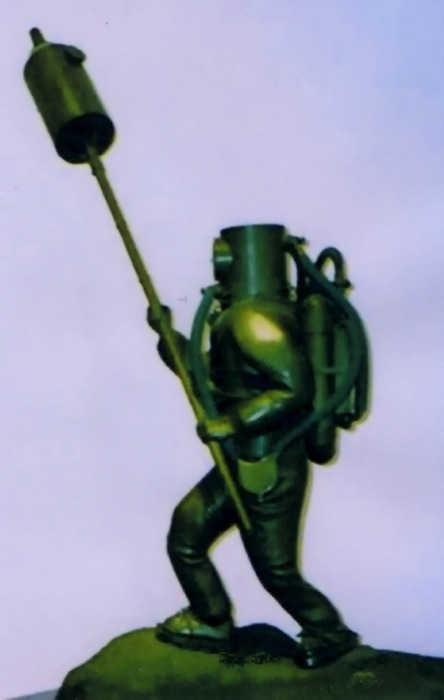
Next door to the Yasukuni shrine in Japan is the Yushukan Museum of the Heroes. Thanks to the efforts of survivors such as Shimizu Kazuro, a statue was placed in the museum to honour the lost Fukuryu trainees, the `human spar torpedoes’, so many of whom lost their lives not in action, but in training.
Drawing from the January 1946 report by the Naval Technical Mission to Japan, index no S-91(N): The Fukuryu Special Harbor Defense and Underwater Attack Unit – Tokyo Bay.
The final manifestation of the spar torpedo concept were the `Crouching Dragons’, or `Fukuryu’, the weapon of a brave and dedicated group of young men of the Imperial Japanese navy’s Special Service Corps in 1945. As seen in the illustration on the next page, here we have an explosive device on the end of a long pole, intended to sink a vessel by exploding against its underwater hull. To all appearances, this is a classic spar torpedo – and conceived as a desperate last resort against a vastly superior naval power, as was the very first spar torpedo.
Unbelievable as it may sound, these sailors were trained as suicide frogmen, prepared to wade out from the invasion beaches, or hole up in diving chambers hidden off the coast in wrecked ships or underwater caves, in order to thrust their spar torpedo into the hull of an Allied landing craft heading for the shores of Japan.
A surviving Fukuryu trainee, Mr Shimizu Kazuro, was interviewed by a journalist at his home in Nagano prefecture in the course of 2013. He described how conditions for the Japanese in 1945 were becoming desperate. As a young naval trainee of just sixteen he was drafted to the `Tokkotai’, the Special Service Corps who made up the kamikaze units. From an initial total of 300 trainees, all firstborn sons, only children, and boys with no father were drafted out, then the trainees thought to be of above-average intelligence were separated and sent away, and the 100 left were the kamikaze recruits.
The Crouching Dragons wore rubber diving suits, and breathed recycled air through a simple arrangement using caustic lye. However, if they forgot to breathe in using their nostrils and exhale though the mouth, they could accidentally inhale caustic lye and quickly lose consciousness. Training consisted of jumping from boats and practising descending to their operating depth, and then they would practise walking on the seabed, guided from a boat by an officer pulling on guide ropes. All too often the trainees would be dragged down by their equipment, which out of the water weighed more than they did, or they would mix up their breathing procedure and suffocate, or the defective brazing on the breathing gear would fail and let in water with disastrous results, or they would simply become entangled in weeds and drown.
Mr Kazuro recalled how at least fifty of his comrades died in this appalling manner. There were too many to cremate in a religious ceremony at the local shrine, so their bodies were simply piled on fires lit along the shore.
Reference works often state that the Fukuryu units were disbanded before hostilities ended because of these appalling casualties. But that was not so. After the news of the Hiroshima and Nagasaki atomic bombs, and the emperor’s radio broadcast, the officers ordered all the equipment and documents to be gathered up and burnt. The Fukuryu were to have remained a closely-guarded secret. It was only after many years that the survivors revived the memory of their lost comrades, and arranged for the small commemorative statue to be made and placed in the Yushukan Museum.